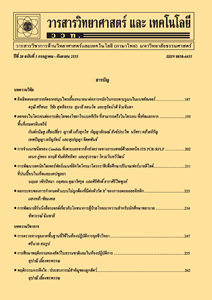การศึกษาสภาวะที่เหมาะสมในการสกัดและการทำแห้งต่อสมบัติทางเคมีกายภาพของกัมเมล็ดมะขาม (Tamarindus indica L.)
Main Article Content
Abstract
บทคัดย่อ
งานวิจัยนี้มีวัตถุประสงค์ในการเพิ่มมูลค่าของเมล็ดมะขาม โดยการสกัดกัมเมล็ดมะขามด้วยน้ำร้อน กรดเจือจาง (0.05 M HCl) และด่างเจือจาง (0.05 M NaOH) ที่อุณหภูมิ 90 oC นาน 3 ชั่วโมง พบว่าสภาวะที่เหมาะสมในการสกัด คือ การใช้น้ำร้อนอุณหภูมิ 90 oC นาน 3 ชั่วโมง ได้กัมที่มีความสามารถในการละลาย (solubility) สูงที่สุด มีความสามารถในการดูดซับน้ำ (water adsorption ratio) สูง ได้ปริมาณผลผลิตกัมร้อยละ 7.73 + 1.01 มีปริมาณคาร์โบไฮเดรตสูงที่สุด แต่ไม่แตกต่างจากการสกัดด้วยกรดเจือจางอย่างมีนัยสำคัญ (p > 0.05) มีค่าความหนืดค่อนข้างสูง จาก FTIR spectra พบว่ากัมที่สกัดทั้ง 3 วิธี มีโครงสร้างที่คล้ายกัน การศึกษาการทำแห้งกัม 4 วิธี ได้แก่ การใช้ตู้อบลมร้อนที่อุณหภูมิ 50 oC นาน 4 ชั่วโมง และ 80 oC นาน 2 ชั่วโมง การทำแห้งแบบสุญญากาศ และการทำแห้งแบบแช่เยือกแข็ง พบว่าการทำแห้งกัมเมล็ดมะขามที่เหมาะสมคือการใช้ตู้อบลมร้อน ที่อุณหภูมิ 80 oC นาน 2 ชั่วโมง มีปริมาณผลผลิตไม่แตกต่างจากการทำแห้งด้วยวิธีการอื่น (p > 0.05) มีปริมาณความชื้นน้อยที่สุด (p < 0.05) มีปริมาณน้ำอิสระ (aw) น้อย และมีค่าความสว่าง (L*) สูงรองจากกัมที่ทำแห้งแบบแช่เยือกแข็ง นอกจากนี้การใช้ตู้อบลมร้อนที่อุณหภูมิ 80 oC ได้กัมที่มีความสามารถในการดูดซับน้ำสูง และมีความสามารถในการละลายน้ำสูงที่สุด ซึ่งไม่แตกต่าง (p > 0.05) จากการใช้ตู้อบลมร้อนที่อุณหภูมิ 50 oC และการทำแห้งแบบแช่เยือกแข็ง
คำสำคัญ : เมล็ดมะขาม; โพลีโอส; ทามารีนกัม; การสกัด; การทำแห้ง
Abstract
The objective of this research was to increase the value of Tamarind seeds. The extraction method for tamarind gum by 90 oC for 3 hours from either water, or diluted hydrochloric acid (0.05 M HCl), or diluted sodium hydroxide (0.05 M NaOH) solution was studied. It was found that the water method gave the most suitable result. The gum obtained had the yield of 7.73 ± 1.01 % with highest solubility, high water adsorption ratio, and high viscosity. However, the carbohydrate content was similar to that from the acid extraction (p > 0.05). From FTIR spectroscopy, the gum from those three methods possessed similar structures. Then, the gum was dried using 4 different methods, i.e., 4 hours in a 50 oC hot air oven, 2 hours in a 80 oC hot air oven, vacuum drying, and freeze drying. It was found that all drying methods gave similar yield of gum (%, p > 0.05), though the gum from the 80 oC hot air oven possessed significantly lowest moisture content (p ≤ 0.05), with low amount of water activity (aw). As of the lightless value (CIE L*), the gum from the 80 oC hot air oven was second from that of the freeze dryer. Moreover, the gum from the 80 oC hot air oven was high in water adsorption ratio and the highest in solubility, which was not significantly different from that of the gum from the 50 oC hot air oven and the freeze drying (p > 0.05).
Keywords: Tamarind seed; polyose; Tamarind gum; extraction; drying

